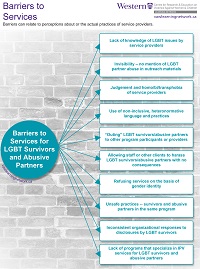Barriers to Services for LGBT Survivors and Abusive Partners
 This infographic lists some of the barriers that exist and that LGBT survivors and abusive partners face when trying to access services and help.
This infographic lists some of the barriers that exist and that LGBT survivors and abusive partners face when trying to access services and help.
View Infographic(PDF)
View Infographic(Image)
View Plain Text PDF
Barriers to Services
Barriers can relate to perceptions about or the actual practices of service providers.
Barriers to Services for LGBT Survivors and Abusive Partners:
- Lack of knowledge of LGBT issues by service providers
- Invisibility – no mention of LGBT partner abuse in outreach materials
- Judgement and homo/bi/transphobia of service providers
- Use of non-inclusive, heteronormative language and practices
- “Outing” LGBT survivors/abusive partners to other program participants or providers
- Allowing staff or other clients to harass LGBT survivors/abusive partners with no consequences
- Refusing services on the basis of gender identity
- Unsafe practices – survivors and abusive partners in the same program
- Inconsistent organizational responses to disclosures by LGBT survivors
- Lack of programs that specialize in IPV services for LGBT survivors and abusive partners
This infographic emerged from Issue-Based Newsletter 12: Intimate Partner Violence in Rainbow Communities.





